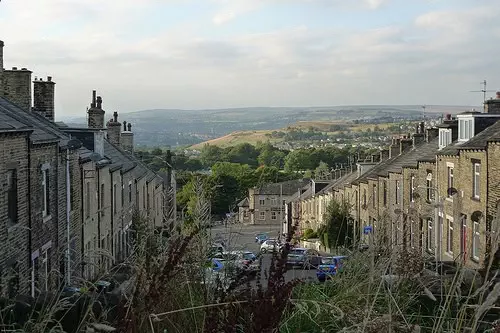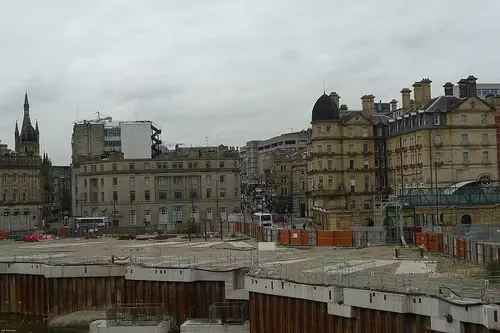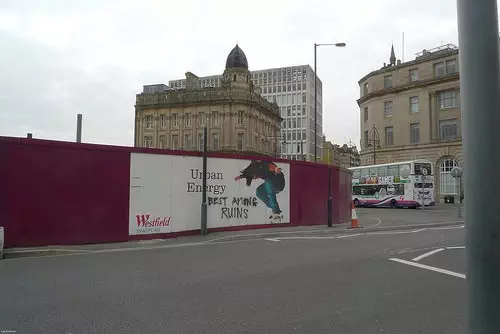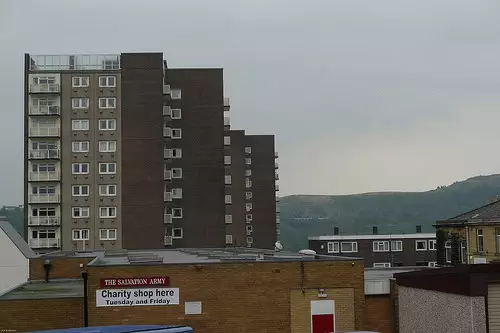
Culture Vulture was lucky enough to get hold of a review copy of Owen Hatherley’s new book, A Guide to the New Ruins of Great Britain. In the introduction he says his argument is that Urban Britain, mainly our Northern towns and cities, “is easily as interesting as the much mythologized piazzas of Italy.” It’s not often that you can say that a 350 page “autopsy of the urban renaissance,” published by the ever so intellectually right on Verso Press was a rollicking, compelling, absorbing read, but I’ve read it twice over the past couple of weeks and haven’t been quite as excited by architectural criticism for a heck of a long time. Owen is genuinely well-informed. One of the reasons it took me so long to read the book was that I kept finding out new things and got distracted checking out all the references to stuff I’d never come across (for instance, the “Googie” roof mentioned in the longer excerpt below.). The research is never dry and worthy though and Owen knows how to tell a damned good story. He’s laugh out loud funny too, sharp, acerbic, critical, unafraid to point out the pomposity and sloppy thinking of the establishment. There’s always a joke, a witty aside or an amusing anecdote to set off the serious point he’s making; “When I mentioned where I was going next to friends and relatives, there was often a certain amount of ridicule—why would you want to go to Leeds, or Milton Keynes, or Halifax?” The book, a kind of modern day version of J B Priestley’s English Journey, shows exactly why the real England and not the Heritage silliness or pastoral pretence favoured by tourist board types is worth getting to know.
The photographs complement the text perfectly; “I took a friend, a theatre photographer and lecturer, along to take pictures, knowing that he would not resort to the clichés, sweeping perspectives and endless summers so beloved of architectural photographers. This—for better or worse—explains the ubiquitous signage, overcast skies and neck-craning angles you will find in the images in this book.” The photographer, Joel Anderson, is introduced early on taking a picture of Wyndham Court in Southampton, which “clearly hasn’t been cleaned in a very long time, and as Joel, gobsmacked, takes several photos, two youths shout over at us, in the fast Estuary/Yokel hybrid that is the Sotonian accent, ‘Itwasn’tmyfaultmydaddidn’tknowjohnniesbroke!’ His urbane Bradfordian sensibilities offended, he asks ‘Can you translate from the vernacular?’, unable to imagine that they’ve been apologizing to us for their very existence. Adjacent is a small bomb site-cum-park, redbrick stumps of buildings, benches, rats and bristling vegetation.”
This little incident perfectly exemplifies the tone of the book, comedy moments embedded in serious critical narrative. Owen explains his purpose;
“This book uses architecture in an unashamedly subjective fashion to illustrate politics and vice versa, and aims most of all to awake in the reader an attention to their urban environment, in the hope that they will see it as something consciously made, something formed, rather than as a more-or-less irritating backdrop to the daily commute, a possible investment or a series of monuments and eyesores. Finally, if this book does that, it is in the hope that from there, people can think about how they can consciously make and consciously transform their environment.”
I think Owen succeeds brilliantly . . . I only wish he’d managed to get to South Leeds, I’d love to know what he’d make of the Holbeck Urban Village! I can only guess. But here, to end with, is a longer excerpt, a lovely piece on our neighbouring towns. The book is out tomorrow, I believe. I can’t recommend it highly enough.
Bradford . . . is a relief after contemporary Leeds, with a sense of real strangeness, drama and uniqueness. Its railway stations may be pathetic and its Portland stone postwar towers might seem to think they’re in Plymouth, but there’s no denying the murky beauty of the city, which supports its one-time claim that while Leeds was famous locally, Bradford is famed internationally.
The local stone is as sombre and powerful as the architecture (usually by local firms such as Lockwood & Mawson), which is mostly neoclassical with experiments in Gothic and Moderne. Yet presumably because of its reputation for poverty and civil unrest, Bradford was largely deprived of the boom’s dubious benefits. From the raised park adjoining the excellent Telegraph & Argus building (and its recent imitation, the Gatehaus) you can survey the vast hole torn in the centre of Bradford which is Blairism’s main Bradfordian legacy. Australian retail developers Westfield had planned to have built and finished a mall here by early 2008, as some local signs still proclaim. In early 2010 they still haven’t started work, nor do they expect to. This failure gives the city the exceptional chance to reject the shopping obsession that has torn the heart out of so many others. The space potentially awaits a park and public housing, if Bradford has the guts.
Aside from the hole, the city has gingerly attempted the Mancunian approach to regeneration (Bradford’s industrial buildings are often better; less prettified, more striking in their fusion of utility and sombre classicism), adapting and reusing some warehouses and mills. This works reasonably well in Little Germany, a warehouse district where the likes of the Behrens family traded for decades. This hilltop area is marked by a mural celebrating the foundation of the Independent Labour Party nearby, and presents a series of canyon-like views and rich juxtapositions, particularly at night when it is utterly deserted. As it is, all roads lead to the Westfield Hole, a purple-fenced mass that is impossible to miss, which reorients the city’s geography, its propaganda posters practically insulting Bradford. ‘Urban Energy’, ‘Café Culture’, ‘City Living’; all those Blairite Urban Renaissance clichés. One of them was defaced when we visited by the graffito ‘BEST AMONG RUINS.’
. . . . . . . . . .
For a southerner, Halifax is another world, a place where ‘Belladonna’, John Cooper Clarke’s paean to an opiated urban Pennine landscape, comes immediately to mind: ‘where the panorama looks like Mars … to the dying gardens, down below …’ The high hills around served as the setting for Wyndham Lewis’s introduction to the North in the 1910s, courtesy of the Vorticist painter and Huddersfield native Edward Wadsworth: ‘[He took] me in his car on a tour of some of Yorkshire’s cities. In due course we arrived on a hill above Halifax. He stopped the car and we gazed down into its industrial labyrinth. I could see he was proud of it. “It’s like Hell, isn’t it?” he said enthusiastically.’ A century later, waiting at a road junction, looking around at the tower blocks, derelict mills and two-up-two-downs, the sombre local stone, all surrounded by freakishly high impassable hills, themselves enclosed by hedges as if hundreds of miles from a city, the smell of the Nestlé factory wafting over, all under a looming, threatening sky, I said to Joel: ‘This is indubitably the North.’ A voice from a car waiting at the junction agrees, yelling ‘THE NORTH!’ as it drives off. Next to this junction is a pub with the name The Running Man, which fits the general sense of fear and tension perfectly. The Running Man has a rather Googie roof, and a view over the seemingly untouched 1960s estates which have mercifully escaped the hatting given to Wakefield. As we board the Halifax to Wakefield train, some youths ask us ‘Are you FBI?’ Aside from being quite a funny question to ask two men in long coats with neat hair taking pictures, this says more about the Special Relationship between the UK and US than any BBC2 teleplay ever could.



You can now order and buy this little beauty http://ow.ly/2ND7P (I’ve linked to the Guardian Bookshop)
Thanks Phil – my kind of book!! Where Vorticists and Mummblers come together in living ruins…well, that is a realistic portrayal of the built form gone bad and unloved, outside the over-marketed un-reality of false transactional places. I am working currently on a rip-roaring critique with the redoubtable architect Kevin Rhowbotham on continuing professional development for architects to challenge the RIBA, and this is what they need to read. Watch this space for our project, and it WILL involve Phil Kirby.
it’s a very good book. Make sure you check the Guardian bookshop . . . we ought to get a copy for the Architect in Residence.
Owen Hatherley is basically an opinionated PhD student who DOES NOT deserve your cash.
Buy this work of genius instead (or take out the copy of it in Leeds Central Library)
http://www.amazon.co.uk/Naked-City-Death-Authentic-Places/dp/0195382854/ref=sr_1_1?ie=UTF8&s=books&qid=1286212776&sr=8-1
I thought that book was average at best and confused, full of piddly meanderings, and also it’s about New York (and based on someone else’s book, which was a real classic) rather than a book about the cities of Britain by someone who really knows architecture rather than an economist with a grudge.
Plus I despise the notion of authenticity.
I would describe Hatherley as a journalist with some opinions about architecture rather than someone “who really knows architecture”. His wikipedia also claims he is an academic despite the fact that he doesn’t have his PhD yet (bless him). He’s just some southern posho who knows the right people in London media circles. Sharon Zukin, on the other hand, is an internationally respected sociologist with the title Prof. in front of her name. You didn’t like Naked City? Fair enough, I was trying to be helpful not forcing people to buy it, but as I understand it, the book interrogates the idea of ‘authenticity’, so your dislike for all things authentic is not a judgement on the book itself.
He’s Southern alright, but posh? He grew up on the Flower Estate, one of the most socially deprived places in Southampton and a violent shithole. Accent ain’t everything.
Location isn’t everything either. Where did he go to school?
And are you his mum or something?
I’m not his mum, I don’t know where he went to school. But since he refers pretty often to his parents being members of the Communist Party, I’m guessing not Eton.
Sounds like a fascinating read. What’s wrong with opinionated PHD students, George?
And it would be interesting to hear what makes Naked City a work of genius for you…seeing as how it appears from the amazon link you posted to be an analysis of urban space in New York, does it have a relevance for UK urban spaces?
Amusingly, since this article appeared both Amazon and the Guardian Bookshop have put this book on “7-10 day dispatch”. Seems to have been a popular title!
P.S. I overstated the case when i said it was a work of ‘genius’ but for an academic study of NYC it is pretty accessible.
Zukin explains the relevance of her work for considering other cities:
http://www.youtube.com/watch?v=u-b34ef75hc